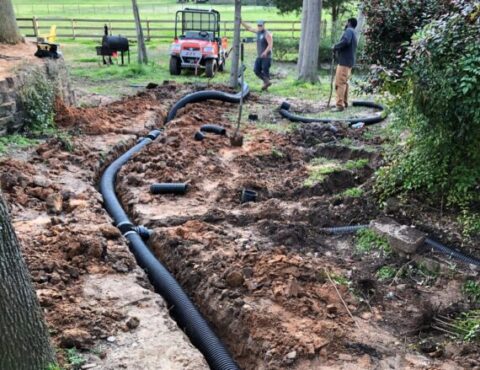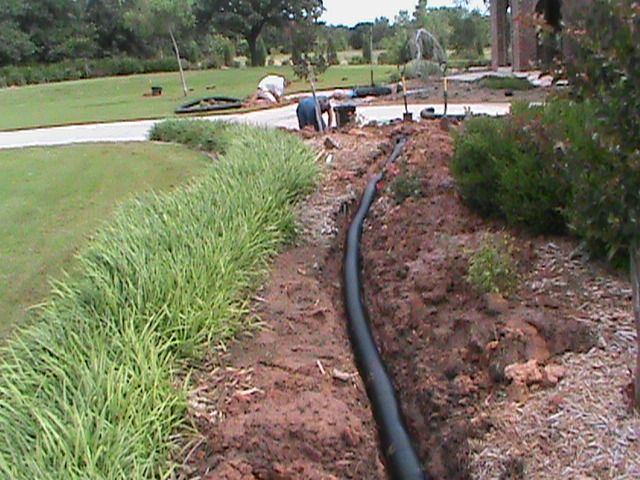Waterlogging is a common problem in many gardens, especially during periods of heavy rainfall. Excess water can damage plants, cause soil erosion, and lead to an overall unhealthy garden environment. If your yard is prone to standing water or soggy soil, it’s essential to find effective garden drainage solutions. Below are some of the top garden drainage systems to help prevent waterlogging, keep your plants healthy, and maintain a dry, functional outdoor space.
1. French Drains
A French drain is one of the most popular and effective ways to manage waterlogging in your garden. It consists of a trench filled with gravel or rock, with a perforated pipe placed at the bottom to allow water to flow through it. The water is then diverted away from the problem area to a more suitable location, such as a soakaway or storm drain.
Benefits:
- Excellent for areas with poor soil drainage.
- Works well in low-lying garden spots where water tends to pool.
- Can be installed discreetly, making it ideal for maintaining garden aesthetics.
2. Soakaways
A soakaway is an underground structure that collects and absorbs excess water from your garden. Typically, it is made from perforated crates or other drainage materials that allow water to gradually seep into the soil, reducing surface water accumulation and preventing waterlogging.
Benefits:
- Ideal for areas where surface drainage isn’t practical.
- Helps water to be absorbed into the ground naturally.
- Can be used in conjunction with other drainage systems like French drains or surface drains.
3. Surface Water Drains
Surface water drains are designed to collect rainwater and runoff from patios, driveways, and other hard surfaces before it reaches the garden. These systems typically use grated channels or slot drains installed along the edges of your garden, which direct water to underground pipes that carry it away from the area.
Benefits:
- Perfect for preventing water from pooling on hard surfaces.
- Can protect garden beds and other landscape features from excessive water.
- Easily installed along walkways, driveways, or garden paths.
4. Swales
A swale is a shallow, sloped trench used to direct water away from garden areas. It is typically filled with grass or other vegetation to help absorb excess moisture while preventing soil erosion. Swales are often used in areas with slopes where water tends to gather and wash away.
Benefits:
- Cost-effective and environmentally friendly solution for water management.
- Can blend into the landscape, adding visual appeal while solving drainage problems.
- Helps reduce runoff and supports soil stability.
5. Permeable Paving
If you have patios, walkways, or driveways in your garden, consider using permeable paving. Unlike traditional concrete or asphalt, permeable paving materials allow rainwater to pass through the surface and infiltrate the ground below. This helps to reduce surface runoff and keep water from accumulating in your garden.
Benefits:
- Ideal for paved areas prone to waterlogging.
- Reduces the need for additional drainage systems.
- Helps maintain soil moisture levels and prevents waterlogging around hard surfaces.
6. Gutter and Downspout Extensions
Water from your roof can contribute significantly to waterlogging in your garden, particularly in areas near your home. Installing gutter and downspout extensions will direct rainwater away from your garden and house foundation, ensuring that excess water doesn’t pool near plants or garden beds.
Benefits:
- Simple, cost-effective way to manage water runoff from your roof.
- Prevents water from accumulating in your yard near the home.
- Can be connected to a drainage system like a French drain or soakaway for more efficient water diversion.
7. Sump Pump Systems
In cases of extreme waterlogging, where water collects in the lowest points of your garden, installing a sump pump can help. A sump pump collects excess water from a sump pit in the garden and pumps it out of the area, often into a designated drainage system or away from the garden entirely.
Benefits:
- Provides a high-capacity solution for flood-prone areas.
- Quickly removes water from problem areas, reducing the risk of plant damage.
- Effective in extreme conditions or flood-prone gardens.

8. Raised Garden Beds
For gardeners dealing with persistent waterlogging, creating raised garden beds can help improve drainage. Raising your garden beds above the ground allows water to flow around the plants’ roots, preventing them from sitting in water and becoming susceptible to rot.
Benefits:
- Helps plants thrive in areas with poor soil drainage.
- Provides better control over the soil quality and moisture levels.
- Adds height and structure to your garden, improving aesthetics.
9. Mulching
While not a full-fledged drainage system, mulching can significantly improve drainage in your garden. A layer of mulch helps to prevent the surface soil from becoming compacted, allowing rainwater to infiltrate the soil more easily. It also helps retain moisture and reduce soil erosion.
Benefits:
- Keeps soil loose and more permeable to water.
- Helps retain moisture while preventing evaporation.
- Can improve the appearance of your garden beds.
10. Aeration Systems
Aeration involves the process of puncturing the soil with small holes to allow air, water, and nutrients to penetrate more effectively. Using an aerator or aeration spikes can help break up compacted soil, allowing for better water infiltration and drainage.
Benefits:
- Ideal for gardens with clay or compacted soils.
- Improves water movement and reduces surface water pooling.
- Increases oxygen availability for plant roots, promoting healthy growth.
Conclusion
Waterlogging in your garden can be frustrating, but with the right drainage solutions, you can keep your yard dry and ensure the health of your plants. From French drains and soakaways to permeable paving and sump pump systems, there are many effective ways to prevent water from accumulating and damaging your garden. By assessing your garden’s drainage needs and implementing the best solution, you’ll enjoy a vibrant, thriving outdoor space that can withstand Coventry’s rainy weather.
